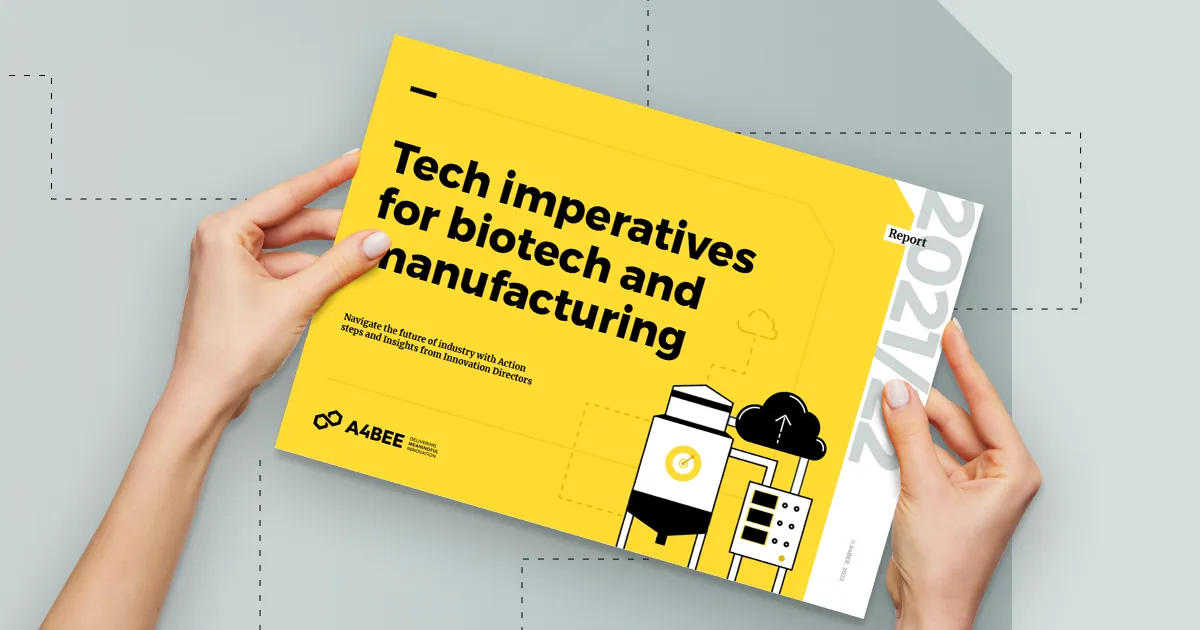7 min read

Introduction
A new wave of priorities has emerged in the ever-changing world of laboratories and manufacturing. Modularity, sustainability, scalability, remote access, and cost optimization are no longer just buzzwords; they are essential pillars of success. Laboratories everywhere are on a quest to boost efficiency and cut costs, leading to a skyrocketing demand for modular lab equipment.
Enter A4BEE, a trailblazer in the industry, addressing these needs with groundbreaking solutions. A4BEE doesn’t just aim to meet the market’s demands; it places bioscientists at the heart of its innovations, ensuring that every product not only fulfills the user requirements but also delivers significant business and market value.
Join us as we further explore the crucial needs for modular lab equipment and the remarkable benefits they bring. This article delves into how these solutions address the pressing demands and pain points of today’s laboratories, offering a glimpse into a more efficient and cost-effective lab of the future.
Advancing Biotech Lab Operations: The Impact of 13 Imperatives on Modularity and Digitalization
Ease of assembly & use
Devices easily assembled and operated by bioscientists or lab operators without extensive training can simplify the setup process. This reduction in the learning curve minimizes downtime and eliminates human errors, leading to quicker experimentation and results. Consequently, operational efficiency increases and training costs are reduced, allowing staff to focus on core research activities. Why does most lab equipment today require extensive training and cannot be used with ease as intuitively as consumer electronics?
Rearrange & reuse
Modular devices that can be rearranged for different setups mitigate the risk of investment in unused hardware. Flexible configurations allow laboratories to adapt to changing needs and projects without significant additional investments. This enhances resource utilization and enables operations to scale up or down based on current demands, ensuring cost-efficiency. Moreover, depending on the process complexity and process-in-time needs, the same modular components could be used to establish different purpose-built machines (bioreactors, mixers, LED controllers, filtering systems, etc.). For example, one pump can be used in process #1 as part of the Bioreactor, and the same pump can be used later in process #2 in the mixer. How would such an approach improve the lab efficiency and reduce the Total Cost of Ownership?
Remote access
Remote access to monitor lab devices from any location is essential for modern labs. Facilitating remote work improves flexibility and ensures continuous monitoring and control, even outside regular working hours. This leads to enhanced work-life balance for staff, reduced need for physical presence, and increased uptime of lab operations. The challenges posed by Covid-19 have shown the value of remote access. Why not apply this to laboratories and their equipment – not just for control but also for monitoring? Less visits to the lab during the weekend (i.e for 7-14 days batch runs) just to check the process status sounds like a great time saver.
‘Under the hood’ complexity
Devices that can be connected and rearranged without specialized IT knowledge make network setup and modifications straightforward. Intuitive systems reduce dependency on IT support, streamlining operations and allowing for faster implementation of changes. This minimizes disruption and ensures seamless workflows. The prerequisite is, of course, the right design focused on the end-user needs and less technical skills than vendors expect or imagine the end-users may have. Then all the technicalities ‘under the hood’ ensure the legacy and new or just existing communication protocols implemented on laboratory equipment integrate seamlessly – the operator shall not care in detail about what’s happening behind the scenes, the outcome is essential, and ease of connectivity to make interconnections working. As simple as that.
LIght & portable
Lightweight and easily shippable devices support dynamic lab environments by facilitating collaboration and resource sharing. Portable equipment allows easy movement between labs or rooms, increasing operational flexibility. This also reduces costs associated with equipment relocation and logistics. Who was in the real lab can confirm if ‘the size matters’. The laboratory space is often expensive; therefore right-sized, lightweight, and possible carrying and moving equipment is the key to optimizing sharing and reusing modular lab equipment. Also, fewer cables mean fewer tickets to IT… who hasn’t been there?
Security
Secure storage of process data to protect intellectual property is not just necessary; it’s critical. Data integrity and security are crucial for maintaining competitive advantage and regulatory compliance. This provides peace of mind regarding data security, fostering trust with stakeholders and clients. Security is not a constraint – it’s an integral part of the design of the solution, especially in the context of modular solutions. The question arises of how mature the market-available lab devices are in the context of secure connectivity and interoperability (industrial protocols supported) when considering their ease of use by the clients.
Power efficiency
Power-efficient devices that measure and optimize power consumption align with sustainability goals and lower operational costs. Reducing energy consumption supports environmental responsibility and results in significant cost savings on energy bills. This approach is beneficial for both the environment and the lab’s budget. That is simple – less power consumption means more devices can be connected in the lab, or the whole equation will be more sustainable in regarding power usage (environmental impact). Also, fewer power supplies and cables mean more space on the lab desk.
Serviceability & support
Devices easily serviced by the user or remotely by the manufacturer simplify maintenance procedures. This reduces downtime and maintenance costs, increasing equipment availability. Consequently, the total cost of ownership is reduced, benefiting the lab’s financial health. Remote serviceability and support are big things– users should expect to solve simple challenges themselves if needed but also deserve to get right-in-time support services for a reasonable cost. Remote capabilities will always lower such a cost.
Data visibility
Real-time visual feedback from devices that signal any issues ensures prompt detection and resolution of problems. This enhances process control and reduces the risk of process disruptions. Effective visual representation of the device state improves operational reliability. In the modularity context, it means that visualization shall be a mix of both physical colors displayed by devices (i.e. traffic-light approach) and digital diagrams or panels available from mobile devices or laptops. Different channels to obtain visual feedback from the ongoing experimentation process are key, and if they can be centralized, that would be even more effective.
Financing and licensing
Flexible financial models allowing leased and paid devices based on usage reduce upfront costs. Aligning expenses with actual usage improves cash flow management and cost-effectiveness. This approach makes advanced technology more accessible and financially manageable. Today’s lab equipment vendors provide complex licensing for the capabilities that bring digitalization into reality, which is a great point to be addressed. Modular lab equipment shall not bring such constraints, because modularity inherently brings some complexity to the lab environment (at the beginning of such a modular lab digitalization journey). Pay-per-use could improve modular devices’ re-usability and lead to optimized equipment utilization.
Cost-effective integration
Cost-effective devices that eliminate the need for costly integration services (with other lab devices or lab management systems, i.e. data platforms) are crucial. By lowering the initial investment and operational costs, advanced technology becomes accessible to a broader range of laboratories, promoting innovation and competitiveness. This cost-saving enables labs to reallocate resources to other critical areas, enhancing overall productivity and profitability. This means that the end-user shall focus on the process and not bear the expectation of integrating lab equipment with other devices, etc. (through extra-paid services) and that devices shall be cost-effective in this aspect.
Centralized management & collaboration
Centralized management software without crazy additional licensing costs simplifies management and reduces hidden expenses by consolidating control systems, streamlining operations, and decreasing the total cost of ownership. This results in more efficient and cost-effective lab management, essential for increasing digital maturity. Many laboratories require centralized monitoring to manage connectivity and process-related data effectively. By eliminating costly licenses, labs can significantly reduce procurement and operational expenses.
Additionally, devices that support lab digitization and seamlessly integrate with central management systems enhance data accuracy, accessibility, and overall efficiency. This digital transformation increases competitiveness and innovation, optimizing costs and accelerating thelab’s digital maturity. As labs progress through different stages of digital maturity, from basic digitization to advanced analytics and automation, seamless integration further reduces integration costs and time, promoting faster deployment and more sophisticated data-driven decision-making capabilities.
Compatibility and compliance
Compatibility with standard industrial protocols and conformance or compliance with regulatory requirements ensure interoperability and legal adherence. Ensuring future-proof operations broadens market access. This approach secures the lab’s position in the market while meeting essential operational standards. As the market is not always demanding fully compliant devices (i.e., in the process-development phase or during R&D activities), it’s more important to have flexibility and speed of experimentation enablers with secure connectivity and data in place rather than a fully compliant setup just to experiment for a few times and never see the Return On Investment…
Summary
By addressing these 13 imperatives of modularity preventing fast digitalization in today’s LAB environments, A4BEE’s modular lab equipment not only meets the diverse needs of modern laboratories but also provides significant business and market value through cost savings, enhanced flexibility, and increased operational efficiency.
For more details on available MODULAR products from A4BEE, please reach out to https://a4bee.com/product/cubes/
#delivering #biotech #innovation






